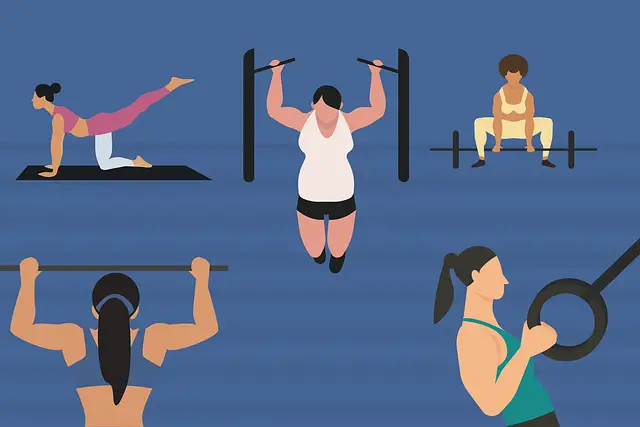Introduction:
The Physical Activity Pyramid serves as a visual representation of the different levels of physical activity individuals can engage in to maintain overall health and well-being. It is a conceptual model designed to guide individuals in incorporating a balanced mix of activities into their daily lives, extending beyond the traditional notion of structured exercise routines.

By understanding the physical activity pyramid, individuals can make informed choices about how to balance different types of activities to meet their fitness goals and maintain a healthy lifestyle. The pyramid serves as a practical guide, encouraging individuals to incorporate a variety of activities that cater to their fitness levels and preferences.
Physical Activity Pyramid Levels:
Level 1
The first level, which is the base of the pyramid, mainly refers to daily physical activities, including walking to and from get off work evemy day, climbing stairs, and daily housework activities.
The basic principle is that in addition to normal rest, it is recommended to do more activities and reduce the time of sitting and lying still. This is the 6,000 steps per day required by the Dietary Guidelines for Chinese Residents.
Level 2
The second level is aerobic low-intensity exercise, usually 3 to 5 times a week, 20 to 60 minutes each time, to benefit the health of the cardiovascular system, improve the body’s cardiopulmonary function, and improve aerobic work. ability.
There are various forms of exercise, including walking, jogging, brisk walking, cycling, swimming, aerobics, various ball games, etc. The intensity of exercise is based on the individual’s age, gender, and physical condition, and is gradual and consistent. of exercise.
Level 3
The third level is strength and flexibility exercises 2 to 3 times a week. Strength exercises with appropriate load can help improve muscle mass and strength, and also contribute to bone health. while flexibility and flexibility exercises can reduce muscle tension, increase muscle relaxation and coordination, improve and maintain body alertness, prevent injuries, and improve Quality of life, etc.

Strength exercises can include push-ups, sit-ups, pull-ups, etc. that rely on your own body weight, or you can use dumbbells or barbells of a certain weight. Flexibility training consists of 5 to 10 minutes of stretching exercises, including squatting, turning, shaking hands, etc., or static stretching exercises.
The principle of static stretching is to stretch as much as possible, with slight discomfort but no pain. Each movement should be stretched for about 20-30 seconds, repeated 2-3 times, and practiced at a slow and controllable speed.
Level 4
The fourth floor, which is also the smallest floor, is mainly used for sitting, resting, reading, and watching TV. The proportion of this part should be reduced in daily life.
Physical Activity Pyramid’s Examples:
The lifestyle activities pyramid encompasses the myriad of daily movements and tasks that collectively contribute to an individual’s physical well-being. These activities are distinct from structured exercises and can be seamlessly integrated into one’s routine. Below are some examples that highlight the diversity of lifestyle activities:
1. Walking or Biking to Work
Choosing to walk or bike to work, if feasible, is a great way to incorporate physical activity into your daily routine. It not only contributes to cardiovascular health but also provides a refreshing start to the day.
2. Gardening
Tending to a garden involves a combination of movements such as digging, planting, and weeding. Gardening not only promotes physical activity but also offers the therapeutic benefits of connecting with nature.
3. Taking the Stairs
Opting for the stairs instead of elevators or escalators is a simple yet effective lifestyle activity. It engages various muscle groups and contributes to cardiovascular fitness.
4. Playing with Pets
Engaging in activities with pets, such as playing fetch or going for a run, not only provides exercise for the pet but also encourages physical activity for the owner.

5. Household Chores
Everyday household chores like vacuuming, sweeping, or mopping involve repetitive movements and contribute to muscle engagement. Turning these tasks into opportunities for physical activity can make a significant difference.
6. Active Hobbies
Pursuing hobbies that involve physical activity, such as dancing, gardening, or recreational sports, adds a fun and enjoyable dimension to staying active. These activities often don’t feel like traditional exercise but offer numerous health benefits.
7. Walking Meetings
Transforming traditional meetings into walking meetings is a practical way to incorporate movement into the workday. It encourages discussion while providing a break from sedentary behavior.
8. Shopping on Foot
Instead of relying on a car for errands, consider walking to the grocery store or other nearby destinations. It’s a practical way to add steps to your day.
9. Stretching Breaks
Taking short breaks throughout the day to stretch and move can help reduce stiffness and enhance flexibility. This can be particularly beneficial for those with desk-bound jobs.
10. Active Commuting
Beyond walking or biking, actively commuting by using public transportation and incorporating walking to and from transit stops adds an element of physical activity to the daily routine.
Health Benefits of Lifestyle Activities:
Lifestyle activities, comprising the routine movements and tasks inherent in daily life, offer a range of health benefits that extend beyond what is typically associated with formal exercise. Understanding and incorporating these activities into one’s routine can significantly contribute to overall physical well-being. Here are key health benefits associated with lifestyle activities:
1. Cardiovascular Health
Engaging in lifestyle activities, such as brisk walking, taking the stairs, or active commuting, promotes cardiovascular health by increasing heart rate and improving blood circulation. These activities contribute to the prevention of cardiovascular diseases.
2. Weight Management
Consistent participation in lifestyle activities helps in weight management by burning calories and maintaining a healthy balance between energy intake and expenditure. This can be particularly beneficial for individuals aiming to achieve or maintain a healthy weight.
3. Improved Mood and Mental Well-being
Lifestyle activities contribute to the release of endorphins, the body’s natural mood lifters. Regular physical activity, even in the form of everyday movements, has been linked to reduced stress, anxiety, and symptoms of depression, promoting overall mental well-being.
4. Enhanced Mobility and Flexibility
The varied movements involved in lifestyle activities, such as stretching, bending, and reaching during household chores or gardening, contribute to improved flexibility and mobility.
5. Increased Energy Levels
Incorporating lifestyle activities into daily routines can boost energy levels. The act of moving, even in small ways, stimulates blood flow and oxygenates the body, providing a natural energy boost that can combat feelings of fatigue.
6. Better Sleep Quality
Regular physical activity, including lifestyle activities, has been linked to improved sleep quality. The exertion and relaxation associated with these activities contribute to a more restful night’s sleep.
7. Prevention of Sedentary-related Issues
Breaking up sedentary periods with short bursts of movement, as seen in lifestyle activities like standing breaks or walking meetings, helps mitigate the negative health effects associated with prolonged sitting. This includes a reduced risk of metabolic issues and musculoskeletal discomfort.
8. Long-Term Health Benefits
Consistent engagement in lifestyle activities contributes to long-term health benefits, reducing the risk of chronic conditions such as heart disease, type 2 diabetes, and certain cancers. These activities, when maintained over time, contribute to a holistic approach to health.
9. Social and Emotional Well-being
Many lifestyle activities, such as playing with pets, active hobbies, or social activities like walking with friends, contribute to social interaction and emotional well-being. These connections are vital for overall health and happiness.
10. Accessible and Sustainable
Lifestyle activities are often more accessible and sustainable than structured exercise routines. Their integration into daily life allows individuals to consistently reap health benefits without the need for specialized equipment or designated workout times.
Highlighting these health benefits reinforces the idea that lifestyle activities are not just incidental but play a crucial role in promoting a comprehensive and sustainable approach to physical well-being. Encourage readers to recognize and appreciate the positive impact of these everyday movements on their overall health.
Conclusion:
In conclusion, understanding the significance of lifestyle activities within the physical activity pyramid unveils a holistic approach to well-being. By recognizing the diverse benefits of daily movements, from improved cardiovascular health to enhanced mental well-being, individuals can embrace a more accessible and sustainable path to fitness.
Lifestyle activities, often overlooked, prove integral to cultivating a healthier lifestyle. Balancing formal exercise with these everyday tasks fosters a comprehensive fitness routine.
As we navigate the tiers of the physical activity pyramid, let’s appreciate the intrinsic value of lifestyle activities, acknowledging their power to transform routine actions into catalysts for enduring health and vitality. Click to learn more.
FAQs:
1. What is the physical activity pyramid?
The physical activity pyramid is a visual representation outlining different levels of physical activities, ranging from sedentary behavior at the base to vigorous exercises at the top. It guides individuals in achieving a balanced and healthy lifestyle.
2. Where do lifestyle activities fit on the physical activity pyramid?
Lifestyle activities, such as walking, gardening, and household chores, span multiple levels of the pyramid. They contribute to both the foundation (sedentary and light activities) and the more intense levels (moderate and vigorous activities).
3. How do lifestyle activities benefit health?
Lifestyle activities offer diverse health benefits, including improved cardiovascular health, weight management, enhanced mood, increased energy levels, and better sleep quality. They also contribute to long-term well-being by reducing the risk of chronic conditions.
4. Can lifestyle activities replace formal exercise?
While lifestyle activities are valuable, they complement rather than replace formal exercise. A balanced approach that combines structured workouts with daily movements ensures a comprehensive fitness routine.
5. How can I incorporate more lifestyle activities into my routine?
Start small by choosing activities you enjoy, like walking or active hobbies. Integrate movement into daily tasks, opt for stairs, and consider active commuting. Consistency is key, and finding enjoyable ways to stay active ensures a sustainable and healthy lifestyle.

3 thoughts on ““In Which Tier of the Physical Activity Pyramid Do Lifestyle Activities Fit?””